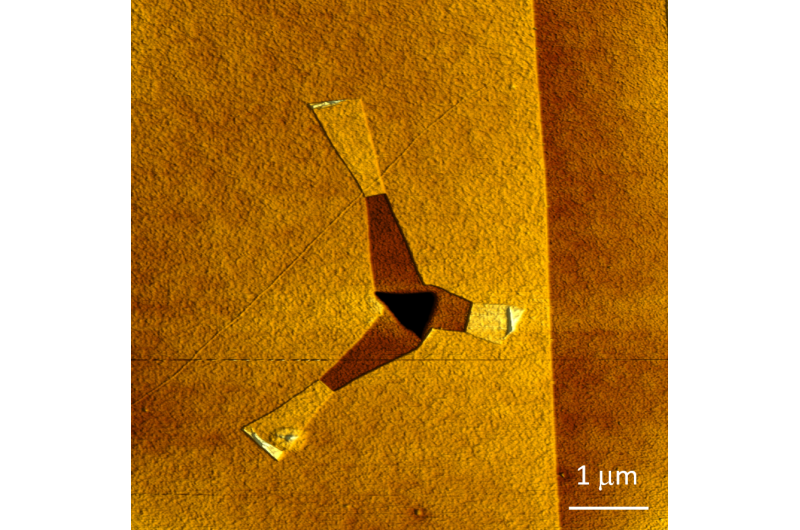July 14, 2016 report
Poking graphene results in peeling and self-assembly of ribbons

(Phys.org)—A pair of researchers with Trinity College in Ireland has found that graphene sheets are capable of spontaneous tearing when heated, which results in peeling and the creation of ribbons. In their paper published in the journal Nature, James Annett and Graham Cross describe how they happened across the new property of graphene, their studies of it, and possible ways it might prove useful.
Graphene continues to be the focus of studies by researchers around the globe, due of course, to its interesting properties—and as a result, researchers are finding out about more and more of its characteristics. In this new effort, the researchers report that when a sheet of graphene experiences a small puncture, parts of the sheet peel back, creating small ribbons of graphene. They came across this finding by accident. They note that as they were testing sheets of the material for friction properties after heating them to 150° C, a small, flower-shaped defect appeared in one.
A closer look revealed that the defect had been caused by a single hole in the original sheet. Intrigued, the team heated another sheet and then poked it with a bit of diamond that had a sharp, three-sided point. The researchers watched as the material around the hole peeled back spontaneously, creating three tiny strips of graphene that lay flat against the original surface. It was the creation of the ribbons that excited the researchers, not the hole—in its native state, the strips grew wider as they grew longer. In one test, they noted that the individual ribbons were approximately 0.6 micros at their thinnest end and tapered at a 15 degree angle—they grew to be approximately 1.5 microns wide at the other end. They report also that rubbing a newly made hole with the tip allowed them to control the peeling to a minor extent.
The researchers plan to continue their study of the peeling effect, looking for a way to cleanly control the process—they believe doing so might present a new way to create transistors, capacitors or other electronic devices.

More information: James Annett et al. Self-assembly of graphene ribbons by spontaneous self-tearing and peeling from a substrate, Nature (2016). DOI: 10.1038/nature18304
Abstract
Graphene and related two-dimensional materials have shown unusual and exceptional mechanical properties, with similarities to origami-like paper folding and kirigami-like cutting6, 7 demonstrated. For paper analogues, a critical difference between macroscopic sheets and a two-dimensional solid is the molecular scale of the thin dimension of the latter, allowing the thermal activation of considerable out-of-plane motion. So far thermal activity has been shown to produce local wrinkles in a free graphene sheet that help in theoretically understanding its stability8, for example, and give rise to unexpected long-range bending stiffness6. Here we show that thermal activation can have a more marked effect on the behaviour of two-dimensional solids, leading to spontaneous and self-driven sliding, tearing and peeling from a substrate on scales approaching the macroscopic. We demonstrate that scalable nanoimprint-style contact techniques can nucleate and direct the parallel self-assembly of graphene ribbons of controlled shape in ambient conditions. We interpret our observations through a simple fracture-mechanics model that shows how thermodynamic forces drive the formation of the graphene–graphene interface in lieu of substrate contact with sufficient strength to peel and tear multilayer graphene sheets. Our results show how weak physical surface forces can be harnessed and focused by simple folded configurations of graphene to tear the strongest covalent bond. This effect may hold promise for the patterning and mechanical actuating of devices based on two-dimensional materials.
Journal information: Nature
© 2016 Phys.org




















